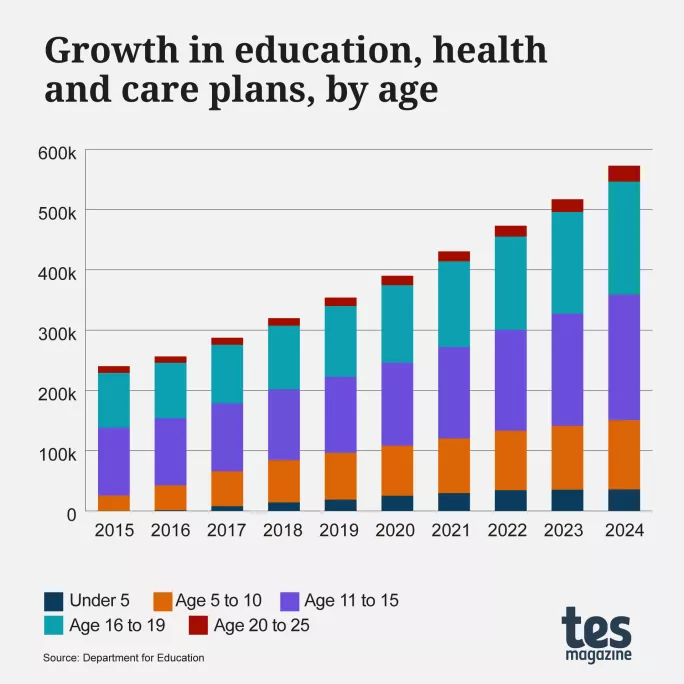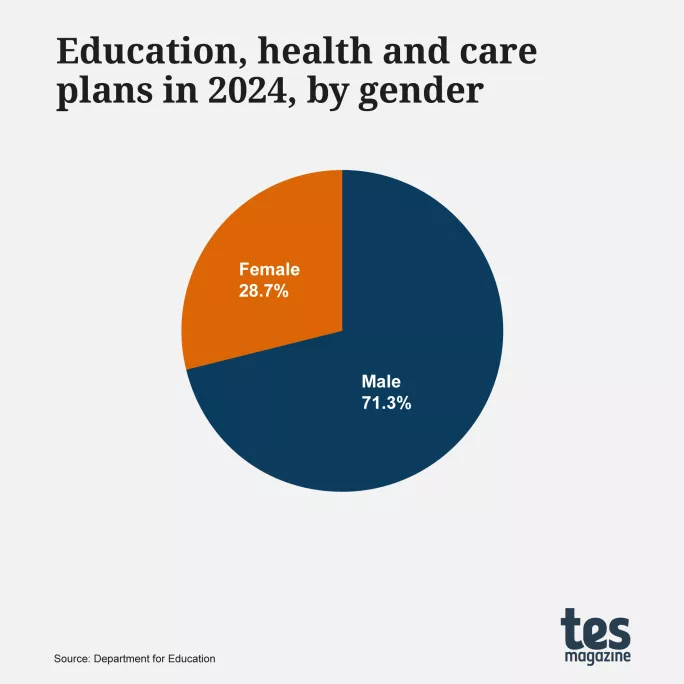7 EHCP insights: age, gender, ethnicity and decision times

The Department for Education has issued its latest annual data on the number of education, health and care plans (EHCPs) issued during 2023 and logged in the January 2024 census - the tenth time such data has been released.
Within the release are a raft of key stats that may be useful for school and trust leaders to be aware of around the pupil cohorts driving this growth and what the future may have in store.
1. Growth of EHCPs continues
The top line figure is that the number of children and young people with an EHCP increased by 58,914 to reach 575,963 - up 11.4 per cent on 2023 when the figure was 517,049.
However, the actual number of new plans issued was 84,428, a 26.6 per cent increase on the year before. The difference is due to some plans ending or being withdrawn as required - most commonly from people leaving education or training.
2. Age group changes
This growth has been driven by increases at all age bands, although some have been far larger than others.
Most notably, children of compulsory school age (5 to 15) rose by 11.6 per cent in total, and now account for 69.1 per cent of all EHCPs.
Broken down into a primary/secondary split, the DfE data shows EHCPs for the 11- to 15-year-old age bracket rose from 186,093 last year to 208,609 this year.
Meanwhile, for children aged 5 to 10, the number of EHCPs went from 168,694 to 187,165.
Children under 5 accounted for 4.6 per cent of EHCPs, reaching 26,527 - an increase of more than 25 per cent since last year, meaning many more primary schools are likely to be working with a pupil with an EHCP in the years ahead.

3. Gender and ethnic data
The data makes it clear that the vast majority of EHCPs are issued to males, who now account for 71.3 per cent of all EHCPs issued, compared with 28.7 per cent for females.

Meanwhile, the majority of EHCPs are issued to white ethnicity pupils at 68.9 per cent, followed by 8.3 per cent for Asian/Asian British, 5.7 per cent for Black/African/Caribbean/Black British, 6.1 per cent for mixed/multiple ethnic groups, and 1.6 per cent for other ethnic groups.
4. Most EHCP pupils in mainstream settings
Despite all these increases, the number of pupils with an EHCP in a special school setting has actually fallen from 33.2 per cent last year to 32.3 per cent this year.
Conversely, the number being taught in a mainstream school has risen from 41.3 per cent to 43.3 per cent.
5. More requests, more rejections
While the number of EHCPs issued rose this year, so too did the number of requests for an assessment that were refused. Specifically, 33,141 requests were rejected - an increase of almost 8,000.
Overall, though, the number of requests made rose to 138,242, a significant increase on last year when 114,482 requests were made.

This meant that despite the rise in rejections, within the 2023 calendar year, 90,500 assessments were made, of which 85,900 resulted in a decision to issue a plan - the majority of which started within 2023.
Only 4,600 assessments did not result in an EHCP being issued.
6. Slight increase in decision times
One glimmer of good news in the data is that despite the increase in referrals, the percentage of EHCPs issued within 20 weeks has slightly increased from 2022 - rising from 49.2 per cent to 50.3 per cent.
This is still some way from the high achieved in 2017 when over 60 per cent of cases were resolved within 20 weeks.
7. Mediations and tribunals
Finally, the data release contains information on the number of mediation cases and tribunals brought by parents to schools and local authorities.
The data shows that within 2023 there were:
- 7,500 mediation cases and 3,400 tribunal cases following the decision as to whether to proceed with an assessment.
- 1,500 mediation cases and 1,000 tribunal cases following the decision as to whether to issue a plan.
- 1,300 mediation cases and 1,900 tribunal cases for other reasons, including the special educational provision set out in the plan.
The DfE release does not compare this with prior years, saying the ways the data collection has been done this time makes comparisons impossible. Outcomes of these mediations and tribunal cases are also not provided.
For the latest education news and analysis delivered directly to your inbox every weekday morning, sign up to the Tes Daily newsletter
You need a Tes subscription to read this article
Subscribe now to read this article and get other subscriber-only content:
- Unlimited access to all Tes magazine content
- Exclusive subscriber-only stories
- Award-winning email newsletters
Already a subscriber? Log in
You need a subscription to read this article
Subscribe now to read this article and get other subscriber-only content, including:
- Unlimited access to all Tes magazine content
- Exclusive subscriber-only stories
- Award-winning email newsletters



